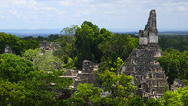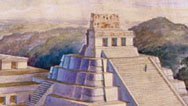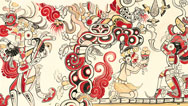Decode Stela 3
- By Mark Van Stone
- Posted 04.08.08
- NOVA
To many of us, Maya hieroglyphs may look like just so many pretty pictures or symbols. But they actually say something, of course, as Mayanists have long known. In this feature, you can actually "read" a passage of glyphs carved into an ancient Maya stela, or dedicatory stone monument. You can both read the ancient Maya (transcribed using the Roman alphabet) and hear it spoken (by Mayanist Barbara MacLeod) as well as read the English translation and accompanying notes. Altogether, you'll get a good taste of the language, and you'll see just how important dates and numbers were to the Maya.
 Launch Interactive
Launch Interactive
Read Maya hieroglyphs carved on an eighth-century stone monument, and hear them spoken aloud.
About Stela 3
This flat stone monument, which stands on a pyramid at the Maya site of Piedras Negras in northwestern Guatemala, shows Lady K'atun-Ajaw, Namaan-Ajaw seated cross-legged on a throne. Her three-year-old daughter is by her side. The monument celebrates the 25th anniversary of her husband's reign. This event happened 99 days before the "period-ending" Maya Long Count date of 9.14.0.0.0.
Just as we do, the Maya felt "round number" jubilees and ends of decades were important. Here the royal couple's scribes have linked the two together with another significant number—99 days. Fanatical numerologists, the Maya appreciated events linked by numbers of days that were multiples of small, significant numbers, such as the number 99 being 9 x 11.
Lady K'atun-Ajaw wears the same outfit in her portrait on Stela 1, another carved stone slab erected at Piedras Negras five years earlier than Stela 3. Though she is standing in Stela 1 rather than sitting, she is holding the same feather fan and making the same gesture with her hands. Gestures were as meaningful in Maya art and performance as they are in, say, Buddhist or Balinese art and dance, but they are still largely undeciphered. This gesture must have something to do with anniversaries.
The cross-like figures that decorate her dress signify the Portal to the Otherworld, which was opened by vision and sacrifice. A similar Portal adorns the jar beside her, which appears to be emitting incense smoke. Her mosaic turban is spangled with disks of shell and a triple diadem of long jade beads. Atop her turban is a "quadripartite badge." An important emblem of sacrificial ritual, the badge carries symbols of the sun, sea, and sky as well as a stingray-spine bloodletting lancet.
On her throne, just beneath her crossed legs, is a damaged image of a reclining lord. (We know it's a man because men wore short skirts, women long.) The lord holds an enormous "Vision Serpent." Its two heads spit out the same hieroglyph, which gives the name of the throne: "Black-Earth-Flower-Place." This glyph also appears—in a better state of preservation—on each of the throne's two squat legs.
On the front of the stela—what you see in this feature is the rear—was a portrait of her husband standing before a similar throne. But it is almost completely eroded from lying face-up in the jungle for 1,300 years. The hieroglyphic texts on the sides of this stela are damaged but mostly readable. Alas, this monument represents one of the better-preserved Maya carved stones. The jungle—and the vandals of history—are not friends of preservation. Fortunately, scholars estimate that what lies buried and thus protected remains far greater than what we have unearthed.—M.V.S.
Credits
Images
- (Photograph, PNG: St.3)
- Teobert Maler from Corpus of Maya Hieroglyphic Inscriptions, Vol. 9, Part 1, Piedras Negras, © 2003 by the President and Fellows of Harvard College
- (Drawing, PNG: St.3)
- David Stuart from Corpus of Maya Hieroglyphic Inscriptions, Vol. 9, Part 1, Piedras Negras, © 2003 by the President and Fellows of Harvard College
Related Links
-

Speaking Ancient Maya
Anthropologist Barbara MacLeod says that studying the ancient Maya language offers a unique window into the past.
-

Cracking the Maya Code
The story behind the centuries-long decipherment of ancient Maya hieroglyphs
-

Deciphering Maya: A Time Line
Trace key discoveries in the effort to understand the Maya script.
-

A Maya Masterpiece Revealed
Explore a 2,000-year-old mural, one of the most exciting recent discoveries of early Maya art.
You need the Flash Player plug-in to view this content.

